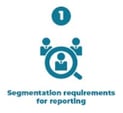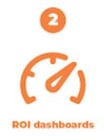Data and reporting requirements are key to business success and to understand how you are performing against your business goals. The landscape and the ability to measure, report and iterate is growing and changing daily - from storytelling to data visualisation. It is no longer possible (or recommended) to be measuring your business through the use of spreadsheets alone.
Today, businesses need to focus on generating, analysing and applying data (data analytics) which requires a high level of data literacy.
Gartner defines data literacy as “The ability to read, write and communicate data in context. This includes an understanding of data sources and constructs; analytical methods and techniques applied; and the ability to describe the use case, the application and the resulting value.”
Based on the data hygiene requirements and the data analytics required, you need to ensure that the software you select supports your reporting requirements. This needs to include security for your data, report customisation, scalability, and reliability.
Data helps you better understand your customer and the journey that they take with your brand. It assists you with prioritisation, it guides you where to make incremental improvements, it assists with product development and insights. With the correct transparency in your reporting, you are able to break down the reporting silos across teams.
Sales, marketing and customer service reporting, in particular, helps businesses in a number of key ways and is a key feature to consider.
- CRM reporting helps businesses to refine what is happening in the business against their set goals
- The data helps with making strategic business decisions
- Managers in marketing, sales and customer service can track performance and make tactical and timely changes when necessary
- The data indicates trends as well as time period specific comparisons - using filters allows for better analysis
- Benchmarks against industry standards are important as well as benchmarks based on your own performance
- Dashboards allow for a high level overview of the business across the marketing, sales and services and allowing each of the divisions to do further deep dives into reporting and analytics to arrive at actionable insights
- Select your metrics - just because you can measure doesn't mean you should
- At the same time, remember, you can’t manage what you can’t measure
In this series of four articles, we will discuss reporting best practices under the following topics:

Understanding the reporting requirements will guide you in the selection of both your marketing, sales and customer service software but also in the selection of how you want this to be visualised.
 Segmentation requirements
Segmentation requirements
Segmentation is key to reporting in order to be able to drill down into each data point but also to compare or triangulate data points. Segments should be able to be monitored in lists which are automatically updated on one or more criteria or through the use of filters and saved reporting views. This needs to be seen in terms of contacts, companies, deals and tickets. This segmentation also needs to be partitioned by teams to ensure privacy.
Segmentation is the foundation on which the reporting dashboards are built - data rich analysis comes from metrics that compare multiple data points.
Contact Segmentation
Contacts are the individuals within your database. Segmentation of contacts allows you to understand them on both an individual level as well as assisting you in finding commonality. Contact segmentation is vital for personalisation throughout their engagement with your business.
Company Segmentation
Company segmentation is important when understanding which companies are most active with your business.
Deal segmentation
Segmenting deals is important to be able to drill down into where and by who you are generating most business or losing deals.
Ticket segmentation
Ticket segmentation is similar to that of deals. It allows your team to understand where to focus their energy but also gives marketing valuable information for creating onboarding content, improving the onboarding process, FAQ posts, information for client portals etc.
 ROI Dashboard
ROI Dashboard
Required ROI measures from your marketing, sales and services software include but are not limited to:
- Business dashboard
- Budget YTD
- Forecast
- Cashflow
- Conversion rate by source
- Visitor to contact
- Contact to customer
- Time to close sale segmented by:
- Source
- Sales rep
- Product
- Business unit
- Industry
- Marketing Cost of sale segmented by:
- Source
- Product
- Business unit
- Industry
- Campaign reporting
- New contacts by campaign
- Influenced contacts by campaign
- Closed deals by campaign
- Influenced revenue by campaign
- NPS score over time segmented by
- Business
- Product
- Industry
- Team
These reports are essential for high level measurement of your goals in order to make strategic business decisions.

In our next article in the series, we will be looking at the 11 marketing reports to include in your HubSpot dashboard.
Sign up to receive the remainder of the series direct to your inbox!
